Finance in Hospitality: Financial Analysis and Budgetary Control
VerifiedAdded on 2019/12/03
|17
|4572
|157
Report
AI Summary
This report provides a detailed analysis of financial management within the hospitality sector, addressing various aspects such as finance sources, cost elements, and budgetary control. The report begins by exploring funding options available to Mr. Stephen, including loans and leasing, along with their associated advantages and disadvantages. It then delves into methods for enhancing income generation, focusing on sales, sponsorships, and grants. The report further examines cost elements, gross profit calculations, and selling price determination. It also covers inventory and cash control methods, including stock levels and cash budgets. A trial balance is prepared, business accounts are evaluated, and adjustments are made. The process and purpose of budgetary control are explained, including variance analysis. The report concludes with an analysis of financial statements, offering insights into appropriate future management strategies and a classification of costs, calculation of contribution and cost volume relationship, and short-term management decisions based upon profit/loss potential and break even analysis.
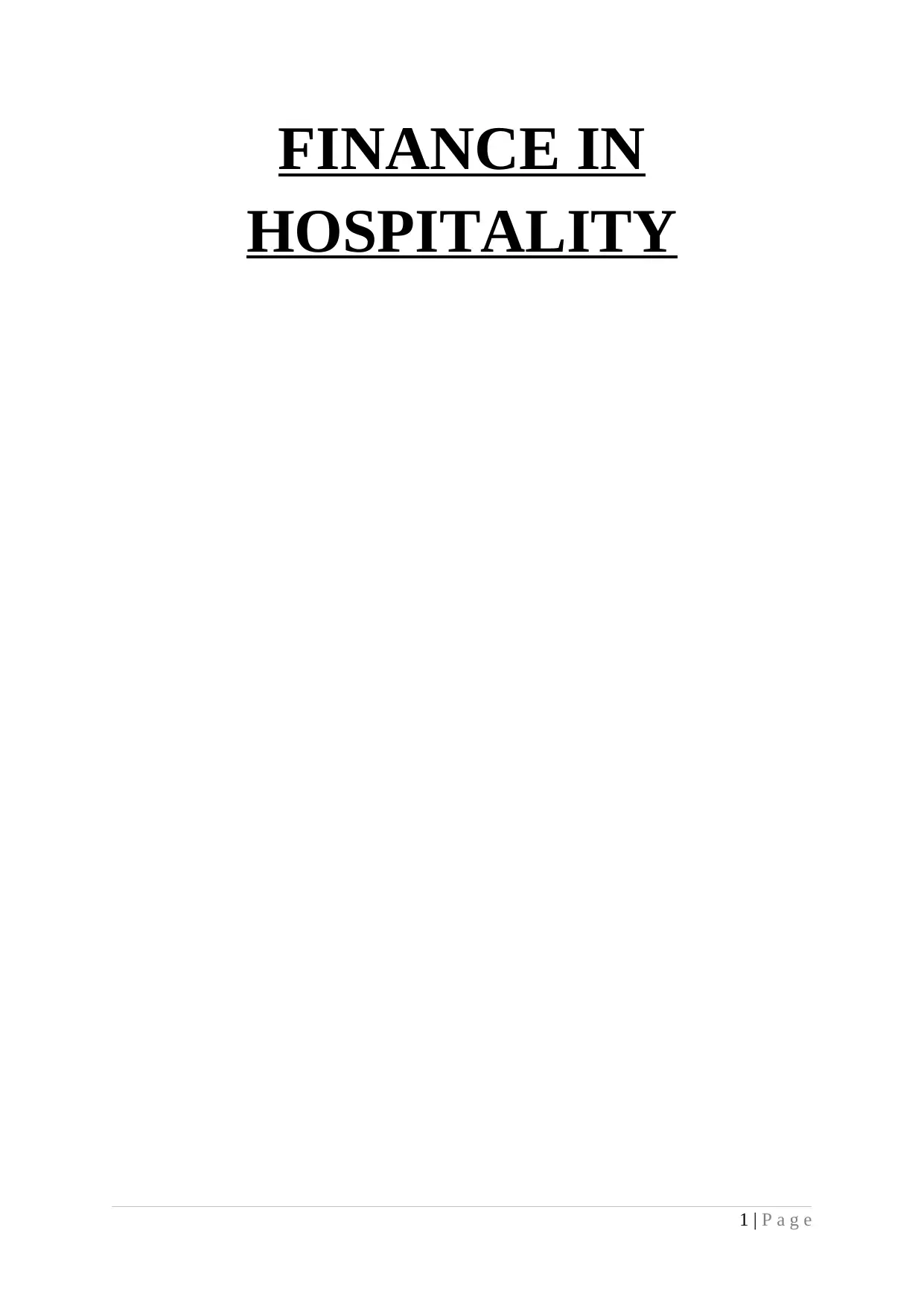
FINANCE IN
HOSPITALITY
1 | P a g e
HOSPITALITY
1 | P a g e
Paraphrase This Document
Need a fresh take? Get an instant paraphrase of this document with our AI Paraphraser
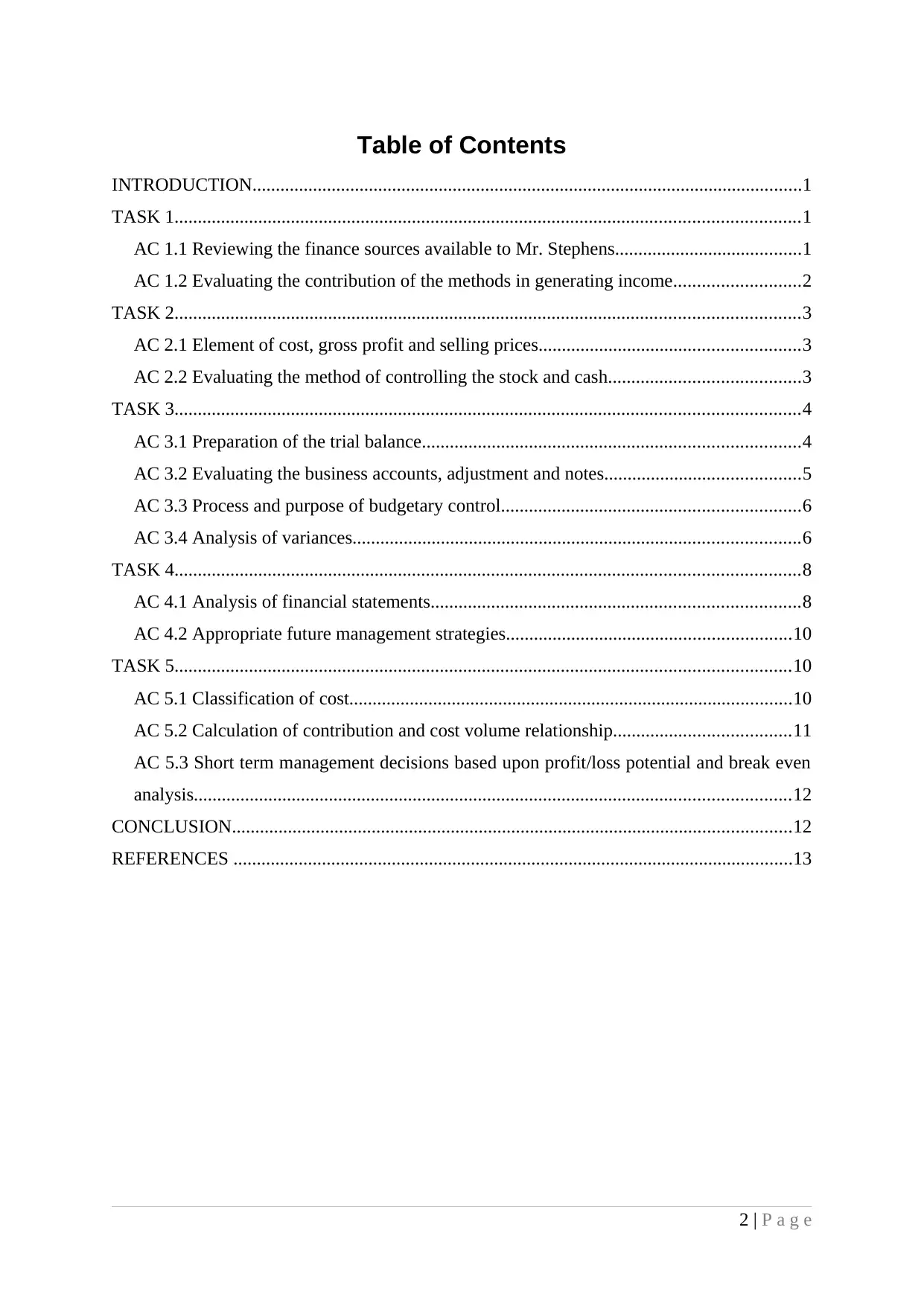
Table of Contents
INTRODUCTION......................................................................................................................1
TASK 1......................................................................................................................................1
AC 1.1 Reviewing the finance sources available to Mr. Stephens........................................1
AC 1.2 Evaluating the contribution of the methods in generating income...........................2
TASK 2......................................................................................................................................3
AC 2.1 Element of cost, gross profit and selling prices........................................................3
AC 2.2 Evaluating the method of controlling the stock and cash.........................................3
TASK 3......................................................................................................................................4
AC 3.1 Preparation of the trial balance.................................................................................4
AC 3.2 Evaluating the business accounts, adjustment and notes..........................................5
AC 3.3 Process and purpose of budgetary control................................................................6
AC 3.4 Analysis of variances................................................................................................6
TASK 4......................................................................................................................................8
AC 4.1 Analysis of financial statements...............................................................................8
AC 4.2 Appropriate future management strategies.............................................................10
TASK 5....................................................................................................................................10
AC 5.1 Classification of cost...............................................................................................10
AC 5.2 Calculation of contribution and cost volume relationship......................................11
AC 5.3 Short term management decisions based upon profit/loss potential and break even
analysis................................................................................................................................12
CONCLUSION........................................................................................................................12
REFERENCES ........................................................................................................................13
2 | P a g e
INTRODUCTION......................................................................................................................1
TASK 1......................................................................................................................................1
AC 1.1 Reviewing the finance sources available to Mr. Stephens........................................1
AC 1.2 Evaluating the contribution of the methods in generating income...........................2
TASK 2......................................................................................................................................3
AC 2.1 Element of cost, gross profit and selling prices........................................................3
AC 2.2 Evaluating the method of controlling the stock and cash.........................................3
TASK 3......................................................................................................................................4
AC 3.1 Preparation of the trial balance.................................................................................4
AC 3.2 Evaluating the business accounts, adjustment and notes..........................................5
AC 3.3 Process and purpose of budgetary control................................................................6
AC 3.4 Analysis of variances................................................................................................6
TASK 4......................................................................................................................................8
AC 4.1 Analysis of financial statements...............................................................................8
AC 4.2 Appropriate future management strategies.............................................................10
TASK 5....................................................................................................................................10
AC 5.1 Classification of cost...............................................................................................10
AC 5.2 Calculation of contribution and cost volume relationship......................................11
AC 5.3 Short term management decisions based upon profit/loss potential and break even
analysis................................................................................................................................12
CONCLUSION........................................................................................................................12
REFERENCES ........................................................................................................................13
2 | P a g e
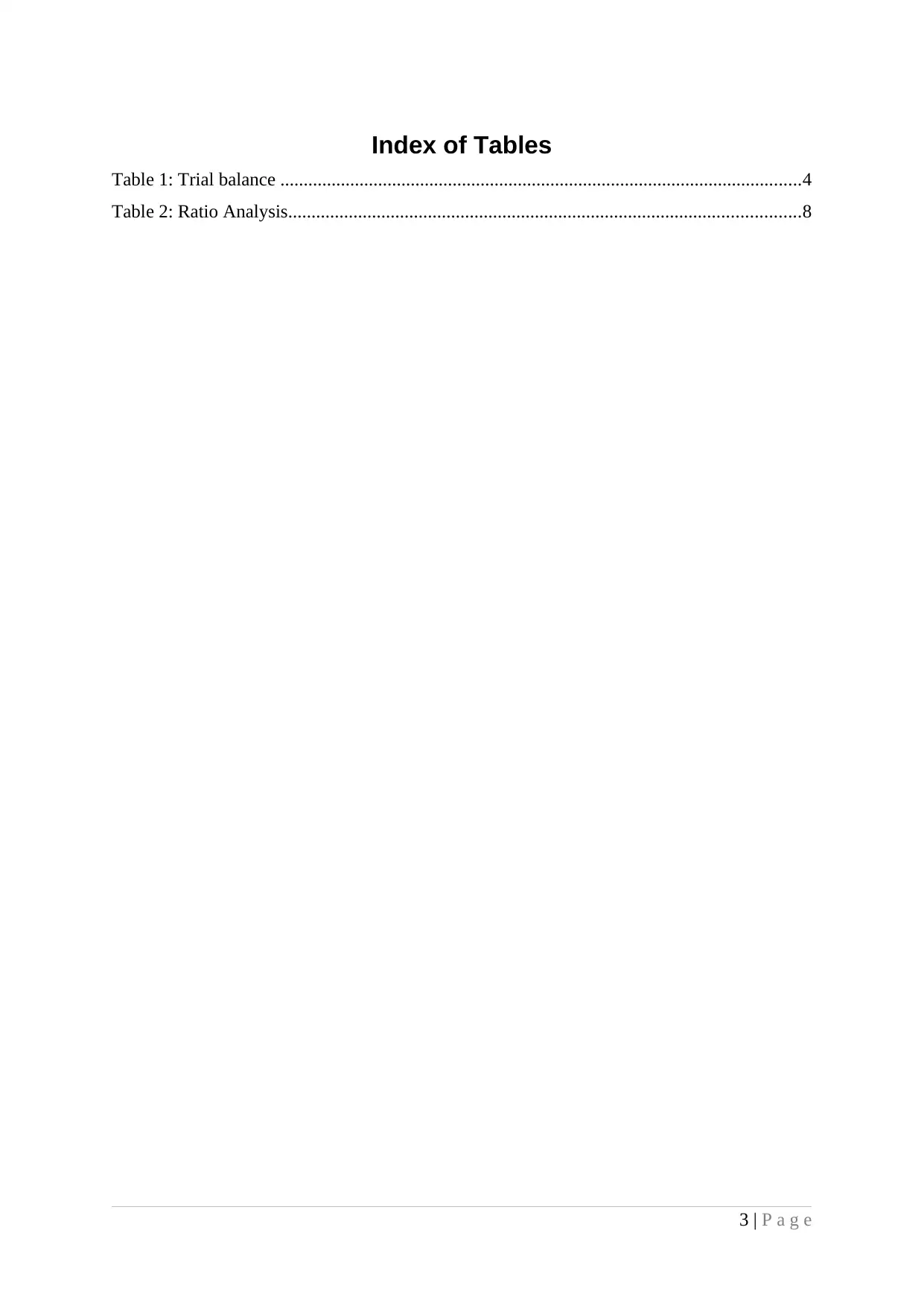
Index of Tables
Table 1: Trial balance ................................................................................................................4
Table 2: Ratio Analysis..............................................................................................................8
3 | P a g e
Table 1: Trial balance ................................................................................................................4
Table 2: Ratio Analysis..............................................................................................................8
3 | P a g e
⊘ This is a preview!⊘
Do you want full access?
Subscribe today to unlock all pages.

Trusted by 1+ million students worldwide
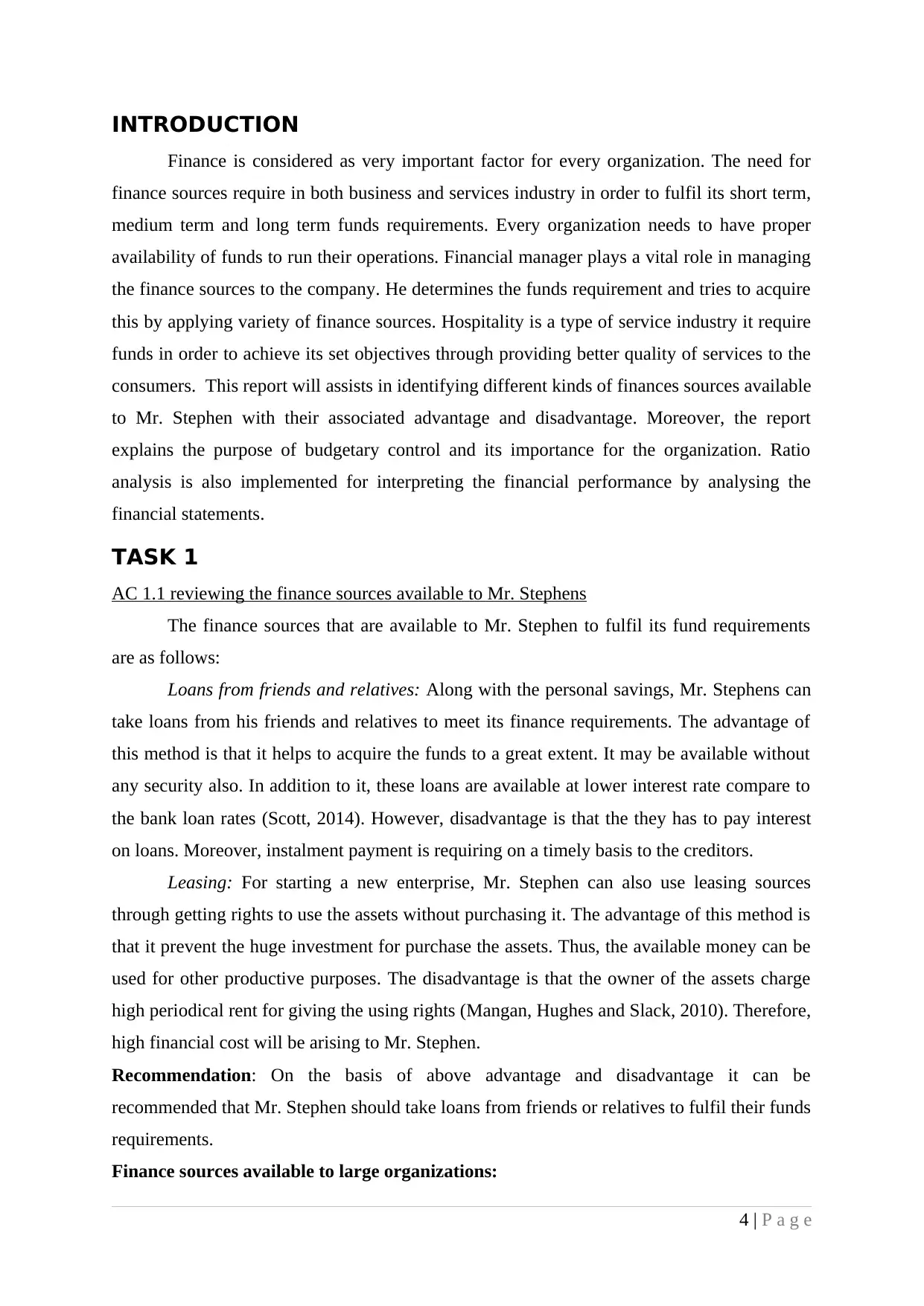
INTRODUCTION
Finance is considered as very important factor for every organization. The need for
finance sources require in both business and services industry in order to fulfil its short term,
medium term and long term funds requirements. Every organization needs to have proper
availability of funds to run their operations. Financial manager plays a vital role in managing
the finance sources to the company. He determines the funds requirement and tries to acquire
this by applying variety of finance sources. Hospitality is a type of service industry it require
funds in order to achieve its set objectives through providing better quality of services to the
consumers. This report will assists in identifying different kinds of finances sources available
to Mr. Stephen with their associated advantage and disadvantage. Moreover, the report
explains the purpose of budgetary control and its importance for the organization. Ratio
analysis is also implemented for interpreting the financial performance by analysing the
financial statements.
TASK 1
AC 1.1 reviewing the finance sources available to Mr. Stephens
The finance sources that are available to Mr. Stephen to fulfil its fund requirements
are as follows:
Loans from friends and relatives: Along with the personal savings, Mr. Stephens can
take loans from his friends and relatives to meet its finance requirements. The advantage of
this method is that it helps to acquire the funds to a great extent. It may be available without
any security also. In addition to it, these loans are available at lower interest rate compare to
the bank loan rates (Scott, 2014). However, disadvantage is that the they has to pay interest
on loans. Moreover, instalment payment is requiring on a timely basis to the creditors.
Leasing: For starting a new enterprise, Mr. Stephen can also use leasing sources
through getting rights to use the assets without purchasing it. The advantage of this method is
that it prevent the huge investment for purchase the assets. Thus, the available money can be
used for other productive purposes. The disadvantage is that the owner of the assets charge
high periodical rent for giving the using rights (Mangan, Hughes and Slack, 2010). Therefore,
high financial cost will be arising to Mr. Stephen.
Recommendation: On the basis of above advantage and disadvantage it can be
recommended that Mr. Stephen should take loans from friends or relatives to fulfil their funds
requirements.
Finance sources available to large organizations:
4 | P a g e
Finance is considered as very important factor for every organization. The need for
finance sources require in both business and services industry in order to fulfil its short term,
medium term and long term funds requirements. Every organization needs to have proper
availability of funds to run their operations. Financial manager plays a vital role in managing
the finance sources to the company. He determines the funds requirement and tries to acquire
this by applying variety of finance sources. Hospitality is a type of service industry it require
funds in order to achieve its set objectives through providing better quality of services to the
consumers. This report will assists in identifying different kinds of finances sources available
to Mr. Stephen with their associated advantage and disadvantage. Moreover, the report
explains the purpose of budgetary control and its importance for the organization. Ratio
analysis is also implemented for interpreting the financial performance by analysing the
financial statements.
TASK 1
AC 1.1 reviewing the finance sources available to Mr. Stephens
The finance sources that are available to Mr. Stephen to fulfil its fund requirements
are as follows:
Loans from friends and relatives: Along with the personal savings, Mr. Stephens can
take loans from his friends and relatives to meet its finance requirements. The advantage of
this method is that it helps to acquire the funds to a great extent. It may be available without
any security also. In addition to it, these loans are available at lower interest rate compare to
the bank loan rates (Scott, 2014). However, disadvantage is that the they has to pay interest
on loans. Moreover, instalment payment is requiring on a timely basis to the creditors.
Leasing: For starting a new enterprise, Mr. Stephen can also use leasing sources
through getting rights to use the assets without purchasing it. The advantage of this method is
that it prevent the huge investment for purchase the assets. Thus, the available money can be
used for other productive purposes. The disadvantage is that the owner of the assets charge
high periodical rent for giving the using rights (Mangan, Hughes and Slack, 2010). Therefore,
high financial cost will be arising to Mr. Stephen.
Recommendation: On the basis of above advantage and disadvantage it can be
recommended that Mr. Stephen should take loans from friends or relatives to fulfil their funds
requirements.
Finance sources available to large organizations:
4 | P a g e
Paraphrase This Document
Need a fresh take? Get an instant paraphrase of this document with our AI Paraphraser
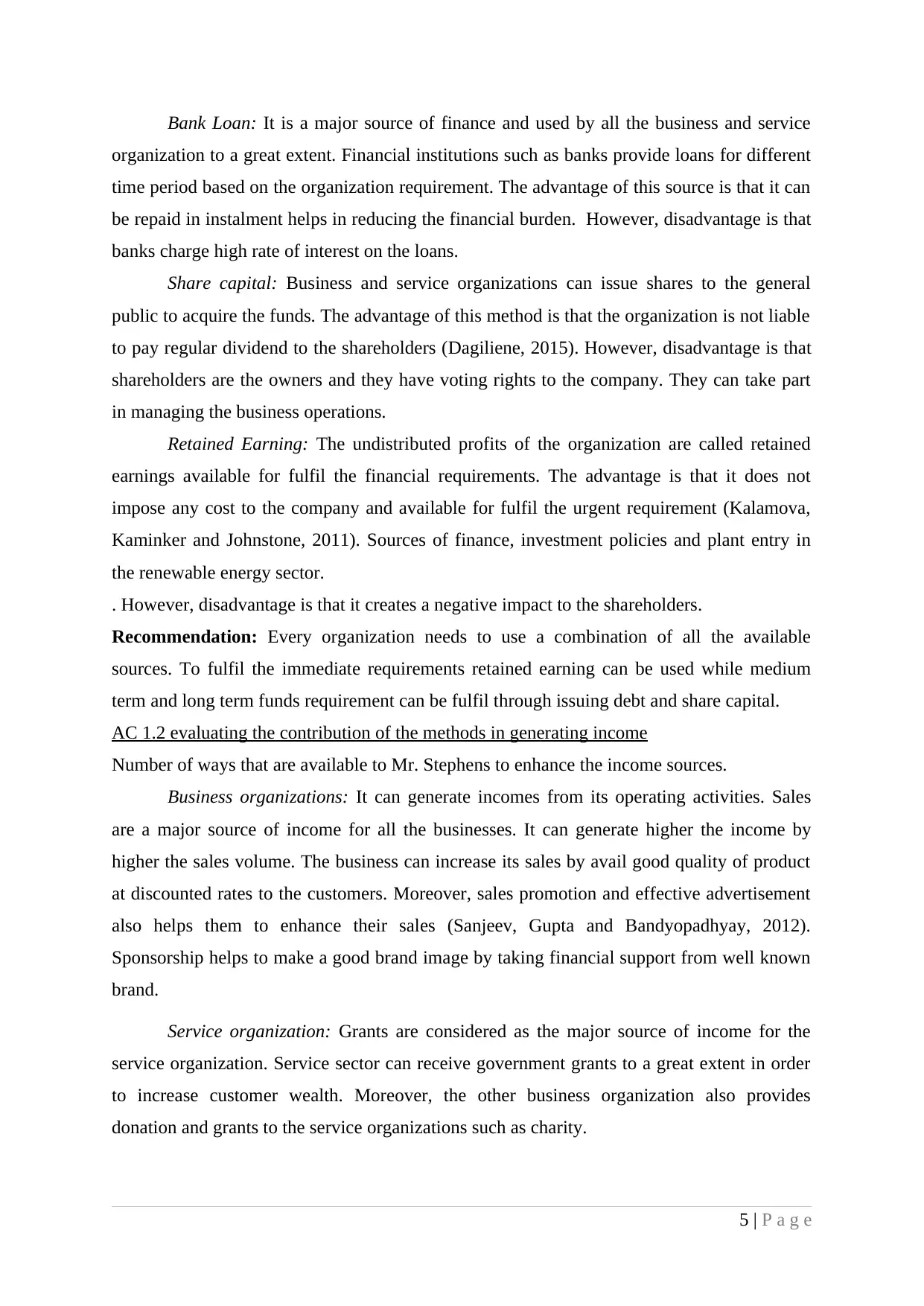
Bank Loan: It is a major source of finance and used by all the business and service
organization to a great extent. Financial institutions such as banks provide loans for different
time period based on the organization requirement. The advantage of this source is that it can
be repaid in instalment helps in reducing the financial burden. However, disadvantage is that
banks charge high rate of interest on the loans.
Share capital: Business and service organizations can issue shares to the general
public to acquire the funds. The advantage of this method is that the organization is not liable
to pay regular dividend to the shareholders (Dagiliene, 2015). However, disadvantage is that
shareholders are the owners and they have voting rights to the company. They can take part
in managing the business operations.
Retained Earning: The undistributed profits of the organization are called retained
earnings available for fulfil the financial requirements. The advantage is that it does not
impose any cost to the company and available for fulfil the urgent requirement (Kalamova,
Kaminker and Johnstone, 2011). Sources of finance, investment policies and plant entry in
the renewable energy sector.
. However, disadvantage is that it creates a negative impact to the shareholders.
Recommendation: Every organization needs to use a combination of all the available
sources. To fulfil the immediate requirements retained earning can be used while medium
term and long term funds requirement can be fulfil through issuing debt and share capital.
AC 1.2 evaluating the contribution of the methods in generating income
Number of ways that are available to Mr. Stephens to enhance the income sources.
Business organizations: It can generate incomes from its operating activities. Sales
are a major source of income for all the businesses. It can generate higher the income by
higher the sales volume. The business can increase its sales by avail good quality of product
at discounted rates to the customers. Moreover, sales promotion and effective advertisement
also helps them to enhance their sales (Sanjeev, Gupta and Bandyopadhyay, 2012).
Sponsorship helps to make a good brand image by taking financial support from well known
brand.
Service organization: Grants are considered as the major source of income for the
service organization. Service sector can receive government grants to a great extent in order
to increase customer wealth. Moreover, the other business organization also provides
donation and grants to the service organizations such as charity.
5 | P a g e
organization to a great extent. Financial institutions such as banks provide loans for different
time period based on the organization requirement. The advantage of this source is that it can
be repaid in instalment helps in reducing the financial burden. However, disadvantage is that
banks charge high rate of interest on the loans.
Share capital: Business and service organizations can issue shares to the general
public to acquire the funds. The advantage of this method is that the organization is not liable
to pay regular dividend to the shareholders (Dagiliene, 2015). However, disadvantage is that
shareholders are the owners and they have voting rights to the company. They can take part
in managing the business operations.
Retained Earning: The undistributed profits of the organization are called retained
earnings available for fulfil the financial requirements. The advantage is that it does not
impose any cost to the company and available for fulfil the urgent requirement (Kalamova,
Kaminker and Johnstone, 2011). Sources of finance, investment policies and plant entry in
the renewable energy sector.
. However, disadvantage is that it creates a negative impact to the shareholders.
Recommendation: Every organization needs to use a combination of all the available
sources. To fulfil the immediate requirements retained earning can be used while medium
term and long term funds requirement can be fulfil through issuing debt and share capital.
AC 1.2 evaluating the contribution of the methods in generating income
Number of ways that are available to Mr. Stephens to enhance the income sources.
Business organizations: It can generate incomes from its operating activities. Sales
are a major source of income for all the businesses. It can generate higher the income by
higher the sales volume. The business can increase its sales by avail good quality of product
at discounted rates to the customers. Moreover, sales promotion and effective advertisement
also helps them to enhance their sales (Sanjeev, Gupta and Bandyopadhyay, 2012).
Sponsorship helps to make a good brand image by taking financial support from well known
brand.
Service organization: Grants are considered as the major source of income for the
service organization. Service sector can receive government grants to a great extent in order
to increase customer wealth. Moreover, the other business organization also provides
donation and grants to the service organizations such as charity.
5 | P a g e

TASK 2
AC 2.1 Element of cost, gross profit and selling prices
Element of cost: There are two types of cost involved in total cost of products and
services that are direct and indirect cost. Direct cost can directly attribute to the specific cost
element also known as prime cost. It includes material, labour and direct overhead cost.
However, indirect cost cannot be attributes to a specific cost object (Datar and et. al., 2013).
It is apportioned on any other basis to the various department of the organization. Both fixed
as well as variable expenditures are prevails under the indirect cost. It includes depreciation
on the assets, manager remuneration and building rent.
Gross profit percentage: The amount of gross profit is the excess of total business
sales over the purchase and direct expenditures. The gross profit percentage is calculated by
dividing the gross profit to the total sales (Blocher and et. al., 2008). Therefore, it has two
elements sales and gross profit earned.
Selling price: Every entrepreneur decides their selling price by adding a profit margin
to the total cost. Thus, selling price has two element cost per unit and profit margin per unit.
By assuming the cost per unit amounted to 500£ and profit percentage is 10%
Selling price = Cost + Profit percentage on cost
= 500£ + 10% of 500£
=500£ + 50£ = 550£
AC 2.2 evaluating the method of controlling the stock and cash
Every organization requires controlling the stock and the cash in order to maximize its
profits. There are different ways available to the organization to control its inventory that is
described below:
Decide various stock levels: Under this method, organization can decide reorder level,
maximum and minimum order level and danger level of stock in order to control its
inventory. It helps the organization to reduce undesired quantity of purchase and helps to
decrease the cost.
Inventory Budget: Budgets can also be prepared for maintain and managing the stock
level. Moreover, it helps to ensure optimum utilization of stock so as to reduce the
deficiencies.
There are different ways available to the organization to control its cash that are described
below:
6 | P a g e
AC 2.1 Element of cost, gross profit and selling prices
Element of cost: There are two types of cost involved in total cost of products and
services that are direct and indirect cost. Direct cost can directly attribute to the specific cost
element also known as prime cost. It includes material, labour and direct overhead cost.
However, indirect cost cannot be attributes to a specific cost object (Datar and et. al., 2013).
It is apportioned on any other basis to the various department of the organization. Both fixed
as well as variable expenditures are prevails under the indirect cost. It includes depreciation
on the assets, manager remuneration and building rent.
Gross profit percentage: The amount of gross profit is the excess of total business
sales over the purchase and direct expenditures. The gross profit percentage is calculated by
dividing the gross profit to the total sales (Blocher and et. al., 2008). Therefore, it has two
elements sales and gross profit earned.
Selling price: Every entrepreneur decides their selling price by adding a profit margin
to the total cost. Thus, selling price has two element cost per unit and profit margin per unit.
By assuming the cost per unit amounted to 500£ and profit percentage is 10%
Selling price = Cost + Profit percentage on cost
= 500£ + 10% of 500£
=500£ + 50£ = 550£
AC 2.2 evaluating the method of controlling the stock and cash
Every organization requires controlling the stock and the cash in order to maximize its
profits. There are different ways available to the organization to control its inventory that is
described below:
Decide various stock levels: Under this method, organization can decide reorder level,
maximum and minimum order level and danger level of stock in order to control its
inventory. It helps the organization to reduce undesired quantity of purchase and helps to
decrease the cost.
Inventory Budget: Budgets can also be prepared for maintain and managing the stock
level. Moreover, it helps to ensure optimum utilization of stock so as to reduce the
deficiencies.
There are different ways available to the organization to control its cash that are described
below:
6 | P a g e
⊘ This is a preview!⊘
Do you want full access?
Subscribe today to unlock all pages.

Trusted by 1+ million students worldwide
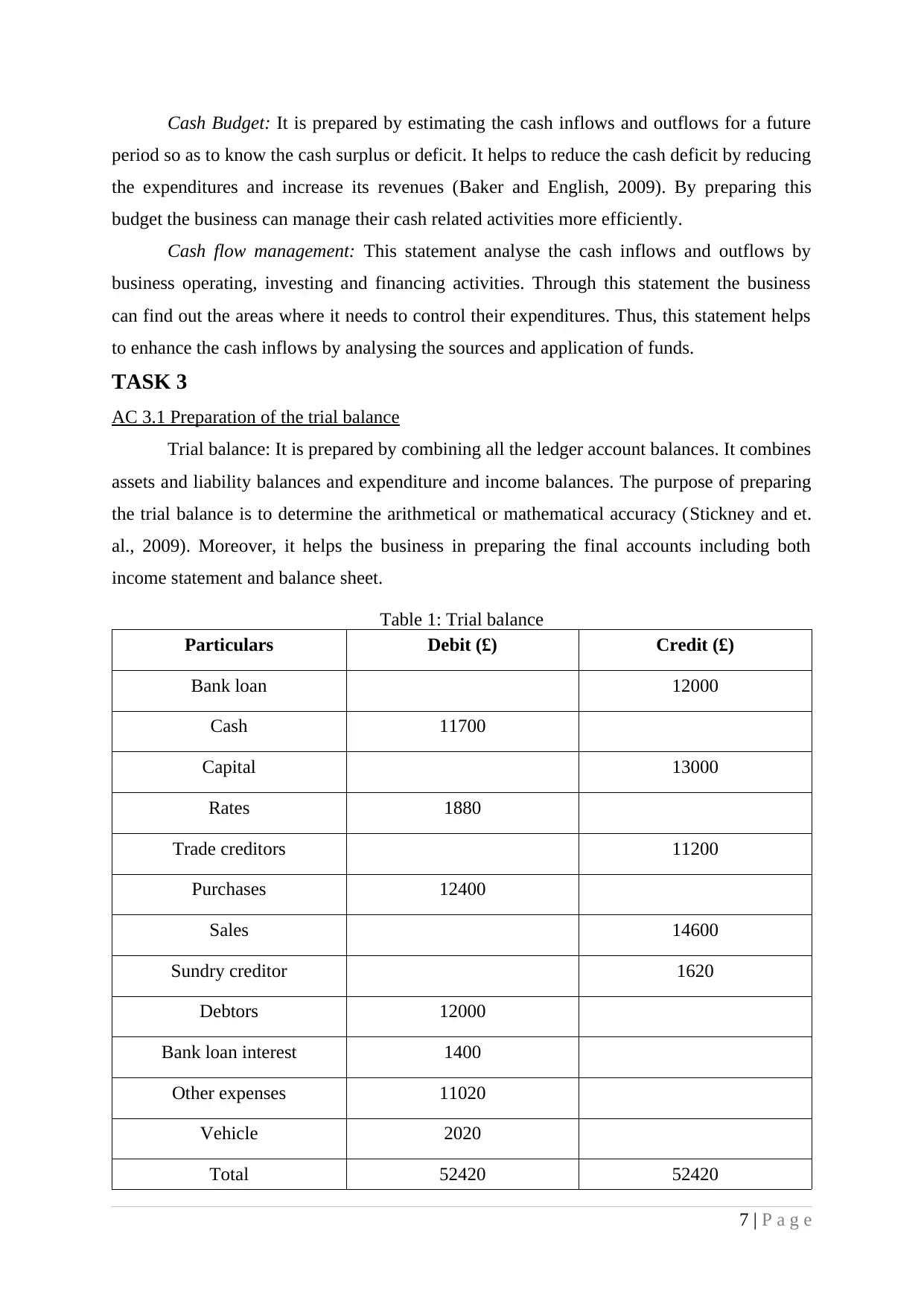
Cash Budget: It is prepared by estimating the cash inflows and outflows for a future
period so as to know the cash surplus or deficit. It helps to reduce the cash deficit by reducing
the expenditures and increase its revenues (Baker and English, 2009). By preparing this
budget the business can manage their cash related activities more efficiently.
Cash flow management: This statement analyse the cash inflows and outflows by
business operating, investing and financing activities. Through this statement the business
can find out the areas where it needs to control their expenditures. Thus, this statement helps
to enhance the cash inflows by analysing the sources and application of funds.
TASK 3
AC 3.1 Preparation of the trial balance
Trial balance: It is prepared by combining all the ledger account balances. It combines
assets and liability balances and expenditure and income balances. The purpose of preparing
the trial balance is to determine the arithmetical or mathematical accuracy (Stickney and et.
al., 2009). Moreover, it helps the business in preparing the final accounts including both
income statement and balance sheet.
Table 1: Trial balance
Particulars Debit (£) Credit (£)
Bank loan 12000
Cash 11700
Capital 13000
Rates 1880
Trade creditors 11200
Purchases 12400
Sales 14600
Sundry creditor 1620
Debtors 12000
Bank loan interest 1400
Other expenses 11020
Vehicle 2020
Total 52420 52420
7 | P a g e
period so as to know the cash surplus or deficit. It helps to reduce the cash deficit by reducing
the expenditures and increase its revenues (Baker and English, 2009). By preparing this
budget the business can manage their cash related activities more efficiently.
Cash flow management: This statement analyse the cash inflows and outflows by
business operating, investing and financing activities. Through this statement the business
can find out the areas where it needs to control their expenditures. Thus, this statement helps
to enhance the cash inflows by analysing the sources and application of funds.
TASK 3
AC 3.1 Preparation of the trial balance
Trial balance: It is prepared by combining all the ledger account balances. It combines
assets and liability balances and expenditure and income balances. The purpose of preparing
the trial balance is to determine the arithmetical or mathematical accuracy (Stickney and et.
al., 2009). Moreover, it helps the business in preparing the final accounts including both
income statement and balance sheet.
Table 1: Trial balance
Particulars Debit (£) Credit (£)
Bank loan 12000
Cash 11700
Capital 13000
Rates 1880
Trade creditors 11200
Purchases 12400
Sales 14600
Sundry creditor 1620
Debtors 12000
Bank loan interest 1400
Other expenses 11020
Vehicle 2020
Total 52420 52420
7 | P a g e
Paraphrase This Document
Need a fresh take? Get an instant paraphrase of this document with our AI Paraphraser
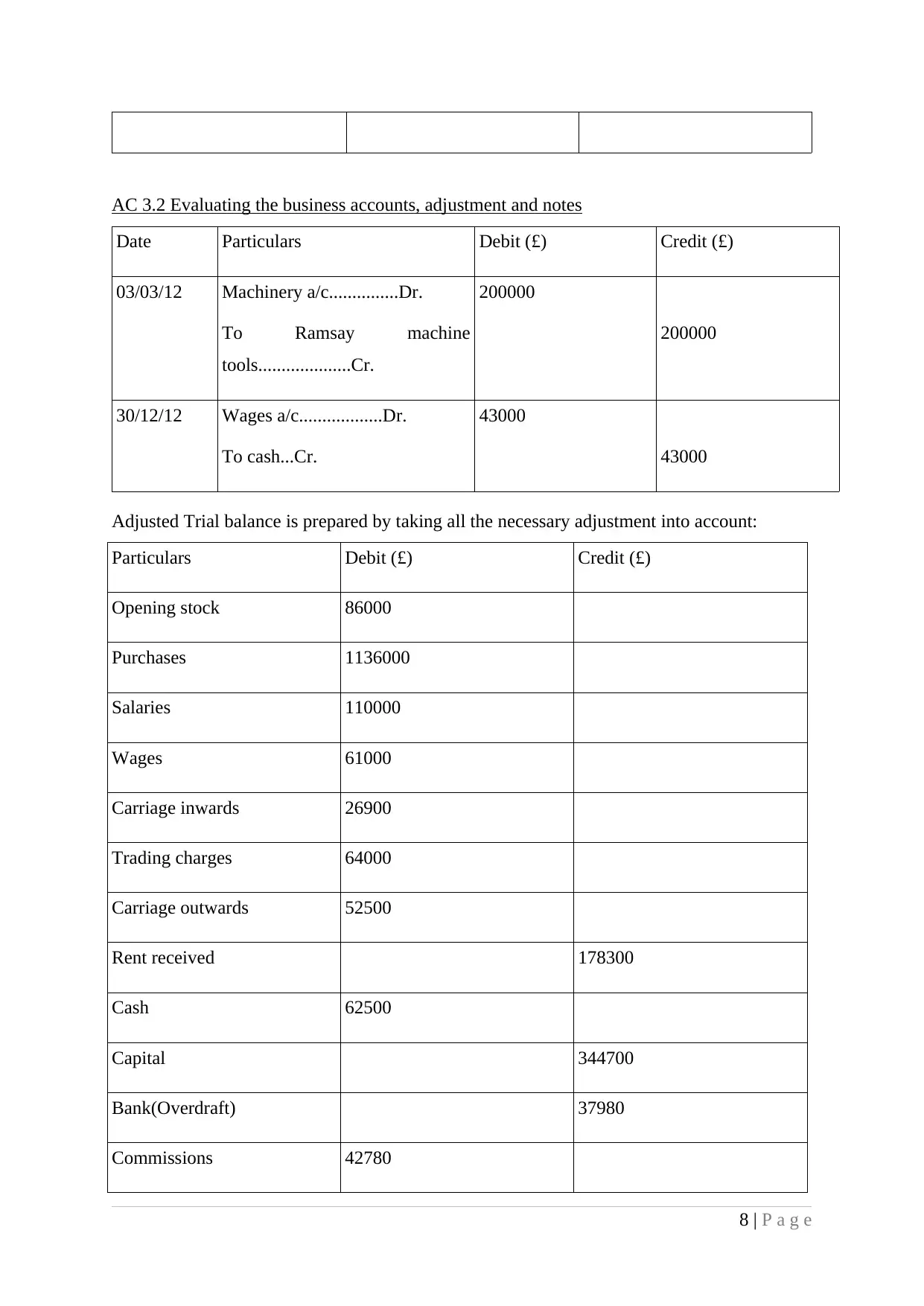
AC 3.2 Evaluating the business accounts, adjustment and notes
Date Particulars Debit (£) Credit (£)
03/03/12 Machinery a/c...............Dr.
To Ramsay machine
tools....................Cr.
200000
200000
30/12/12 Wages a/c..................Dr.
To cash...Cr.
43000
43000
Adjusted Trial balance is prepared by taking all the necessary adjustment into account:
Particulars Debit (£) Credit (£)
Opening stock 86000
Purchases 1136000
Salaries 110000
Wages 61000
Carriage inwards 26900
Trading charges 64000
Carriage outwards 52500
Rent received 178300
Cash 62500
Capital 344700
Bank(Overdraft) 37980
Commissions 42780
8 | P a g e
Date Particulars Debit (£) Credit (£)
03/03/12 Machinery a/c...............Dr.
To Ramsay machine
tools....................Cr.
200000
200000
30/12/12 Wages a/c..................Dr.
To cash...Cr.
43000
43000
Adjusted Trial balance is prepared by taking all the necessary adjustment into account:
Particulars Debit (£) Credit (£)
Opening stock 86000
Purchases 1136000
Salaries 110000
Wages 61000
Carriage inwards 26900
Trading charges 64000
Carriage outwards 52500
Rent received 178300
Cash 62500
Capital 344700
Bank(Overdraft) 37980
Commissions 42780
8 | P a g e
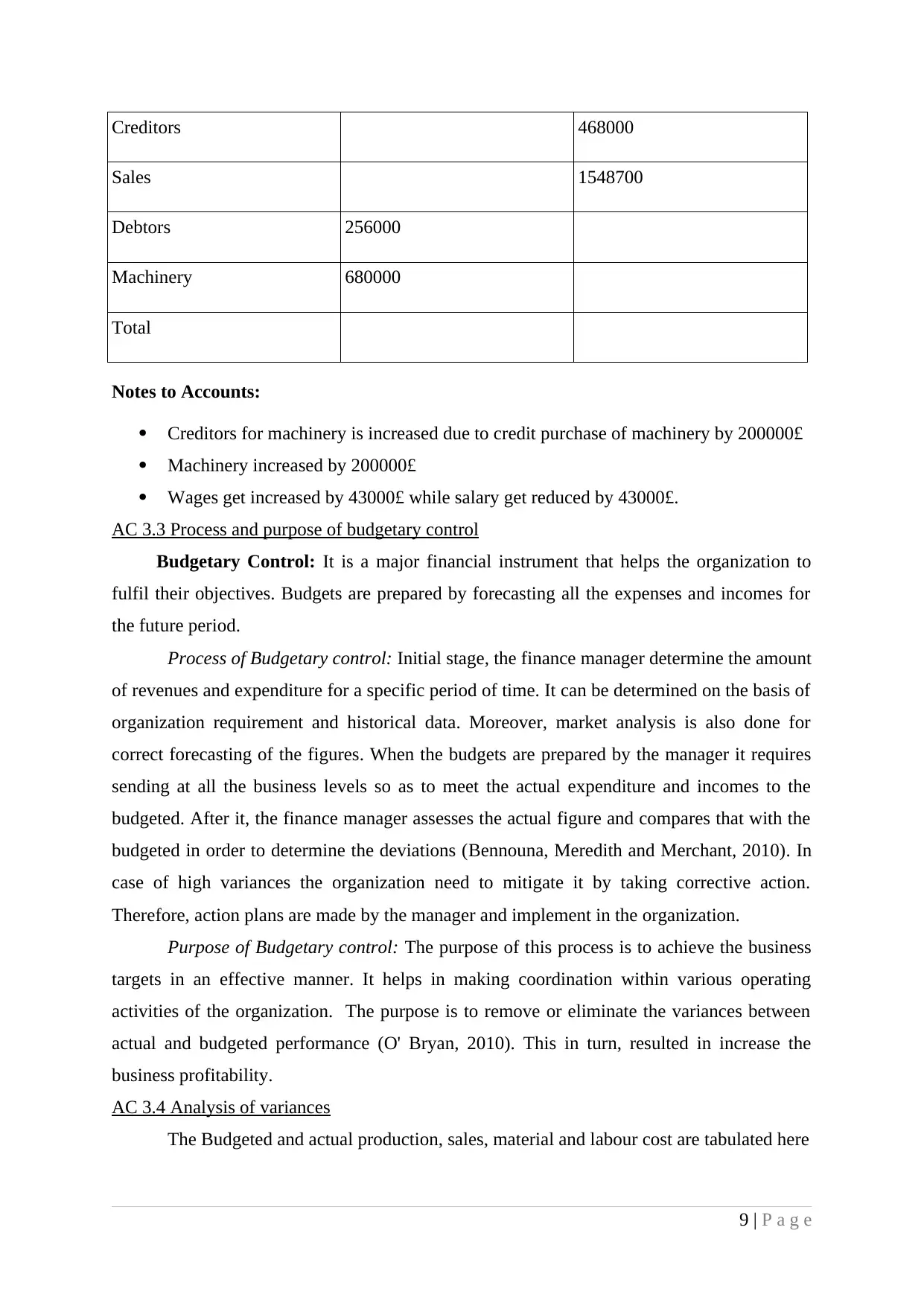
Creditors 468000
Sales 1548700
Debtors 256000
Machinery 680000
Total
Notes to Accounts:
Creditors for machinery is increased due to credit purchase of machinery by 200000£
Machinery increased by 200000£
Wages get increased by 43000£ while salary get reduced by 43000£.
AC 3.3 Process and purpose of budgetary control
Budgetary Control: It is a major financial instrument that helps the organization to
fulfil their objectives. Budgets are prepared by forecasting all the expenses and incomes for
the future period.
Process of Budgetary control: Initial stage, the finance manager determine the amount
of revenues and expenditure for a specific period of time. It can be determined on the basis of
organization requirement and historical data. Moreover, market analysis is also done for
correct forecasting of the figures. When the budgets are prepared by the manager it requires
sending at all the business levels so as to meet the actual expenditure and incomes to the
budgeted. After it, the finance manager assesses the actual figure and compares that with the
budgeted in order to determine the deviations (Bennouna, Meredith and Merchant, 2010). In
case of high variances the organization need to mitigate it by taking corrective action.
Therefore, action plans are made by the manager and implement in the organization.
Purpose of Budgetary control: The purpose of this process is to achieve the business
targets in an effective manner. It helps in making coordination within various operating
activities of the organization. The purpose is to remove or eliminate the variances between
actual and budgeted performance (O' Bryan, 2010). This in turn, resulted in increase the
business profitability.
AC 3.4 Analysis of variances
The Budgeted and actual production, sales, material and labour cost are tabulated here
9 | P a g e
Sales 1548700
Debtors 256000
Machinery 680000
Total
Notes to Accounts:
Creditors for machinery is increased due to credit purchase of machinery by 200000£
Machinery increased by 200000£
Wages get increased by 43000£ while salary get reduced by 43000£.
AC 3.3 Process and purpose of budgetary control
Budgetary Control: It is a major financial instrument that helps the organization to
fulfil their objectives. Budgets are prepared by forecasting all the expenses and incomes for
the future period.
Process of Budgetary control: Initial stage, the finance manager determine the amount
of revenues and expenditure for a specific period of time. It can be determined on the basis of
organization requirement and historical data. Moreover, market analysis is also done for
correct forecasting of the figures. When the budgets are prepared by the manager it requires
sending at all the business levels so as to meet the actual expenditure and incomes to the
budgeted. After it, the finance manager assesses the actual figure and compares that with the
budgeted in order to determine the deviations (Bennouna, Meredith and Merchant, 2010). In
case of high variances the organization need to mitigate it by taking corrective action.
Therefore, action plans are made by the manager and implement in the organization.
Purpose of Budgetary control: The purpose of this process is to achieve the business
targets in an effective manner. It helps in making coordination within various operating
activities of the organization. The purpose is to remove or eliminate the variances between
actual and budgeted performance (O' Bryan, 2010). This in turn, resulted in increase the
business profitability.
AC 3.4 Analysis of variances
The Budgeted and actual production, sales, material and labour cost are tabulated here
9 | P a g e
⊘ This is a preview!⊘
Do you want full access?
Subscribe today to unlock all pages.

Trusted by 1+ million students worldwide

Elements Budgeted
performance
Actual performance Variance
Production (in units) 1200 1000 200
Sales 150000 126000 24000
Material 50000 46075
Labour 20000 21210
Material cost variance, Material price variance and Material usage variance are calculated
here as under:
Elements Budgeted performance Actual performance Variance
Material usage
variance
5000 4850 150
Material price variance 10 9.5 0.5
Material total variance 50000 46075 3925
Conclusion: Budgeted and actual material cost incurred to 50000£ and 46075£. Therefore,
variance is incurred for 3925£. However, material price variance is arise to 0.5 per unit due to
the difference between 10£ and 9.5£. And usage variance is arises to 150£ respectively. All
the variance indicates that company is using its material efficiently. It helps to reduce the
overall cost to the company and enhance its profitability.
Labour efficiency variance, Labour rate variances and labour cost variance are calculated
here:
Elements Budgeted performance Actual performance Variance
Labour efficiency
variance (in hours)
4000 4200 -200
Labour rate variance 5 5.05 -0.05
10 | P a g e
performance
Actual performance Variance
Production (in units) 1200 1000 200
Sales 150000 126000 24000
Material 50000 46075
Labour 20000 21210
Material cost variance, Material price variance and Material usage variance are calculated
here as under:
Elements Budgeted performance Actual performance Variance
Material usage
variance
5000 4850 150
Material price variance 10 9.5 0.5
Material total variance 50000 46075 3925
Conclusion: Budgeted and actual material cost incurred to 50000£ and 46075£. Therefore,
variance is incurred for 3925£. However, material price variance is arise to 0.5 per unit due to
the difference between 10£ and 9.5£. And usage variance is arises to 150£ respectively. All
the variance indicates that company is using its material efficiently. It helps to reduce the
overall cost to the company and enhance its profitability.
Labour efficiency variance, Labour rate variances and labour cost variance are calculated
here:
Elements Budgeted performance Actual performance Variance
Labour efficiency
variance (in hours)
4000 4200 -200
Labour rate variance 5 5.05 -0.05
10 | P a g e
Paraphrase This Document
Need a fresh take? Get an instant paraphrase of this document with our AI Paraphraser
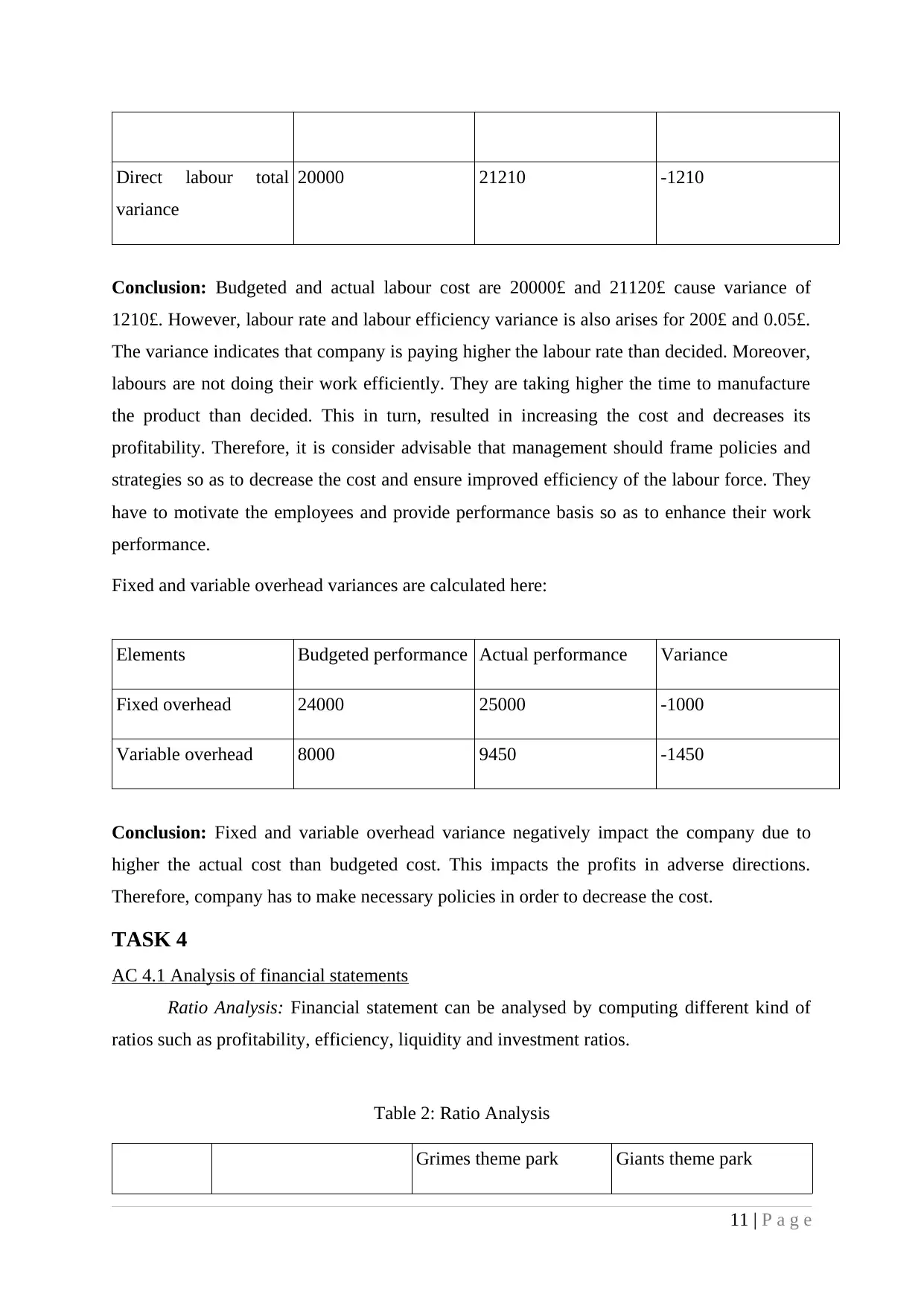
Direct labour total
variance
20000 21210 -1210
Conclusion: Budgeted and actual labour cost are 20000£ and 21120£ cause variance of
1210£. However, labour rate and labour efficiency variance is also arises for 200£ and 0.05£.
The variance indicates that company is paying higher the labour rate than decided. Moreover,
labours are not doing their work efficiently. They are taking higher the time to manufacture
the product than decided. This in turn, resulted in increasing the cost and decreases its
profitability. Therefore, it is consider advisable that management should frame policies and
strategies so as to decrease the cost and ensure improved efficiency of the labour force. They
have to motivate the employees and provide performance basis so as to enhance their work
performance.
Fixed and variable overhead variances are calculated here:
Elements Budgeted performance Actual performance Variance
Fixed overhead 24000 25000 -1000
Variable overhead 8000 9450 -1450
Conclusion: Fixed and variable overhead variance negatively impact the company due to
higher the actual cost than budgeted cost. This impacts the profits in adverse directions.
Therefore, company has to make necessary policies in order to decrease the cost.
TASK 4
AC 4.1 Analysis of financial statements
Ratio Analysis: Financial statement can be analysed by computing different kind of
ratios such as profitability, efficiency, liquidity and investment ratios.
Table 2: Ratio Analysis
Grimes theme park Giants theme park
11 | P a g e
variance
20000 21210 -1210
Conclusion: Budgeted and actual labour cost are 20000£ and 21120£ cause variance of
1210£. However, labour rate and labour efficiency variance is also arises for 200£ and 0.05£.
The variance indicates that company is paying higher the labour rate than decided. Moreover,
labours are not doing their work efficiently. They are taking higher the time to manufacture
the product than decided. This in turn, resulted in increasing the cost and decreases its
profitability. Therefore, it is consider advisable that management should frame policies and
strategies so as to decrease the cost and ensure improved efficiency of the labour force. They
have to motivate the employees and provide performance basis so as to enhance their work
performance.
Fixed and variable overhead variances are calculated here:
Elements Budgeted performance Actual performance Variance
Fixed overhead 24000 25000 -1000
Variable overhead 8000 9450 -1450
Conclusion: Fixed and variable overhead variance negatively impact the company due to
higher the actual cost than budgeted cost. This impacts the profits in adverse directions.
Therefore, company has to make necessary policies in order to decrease the cost.
TASK 4
AC 4.1 Analysis of financial statements
Ratio Analysis: Financial statement can be analysed by computing different kind of
ratios such as profitability, efficiency, liquidity and investment ratios.
Table 2: Ratio Analysis
Grimes theme park Giants theme park
11 | P a g e
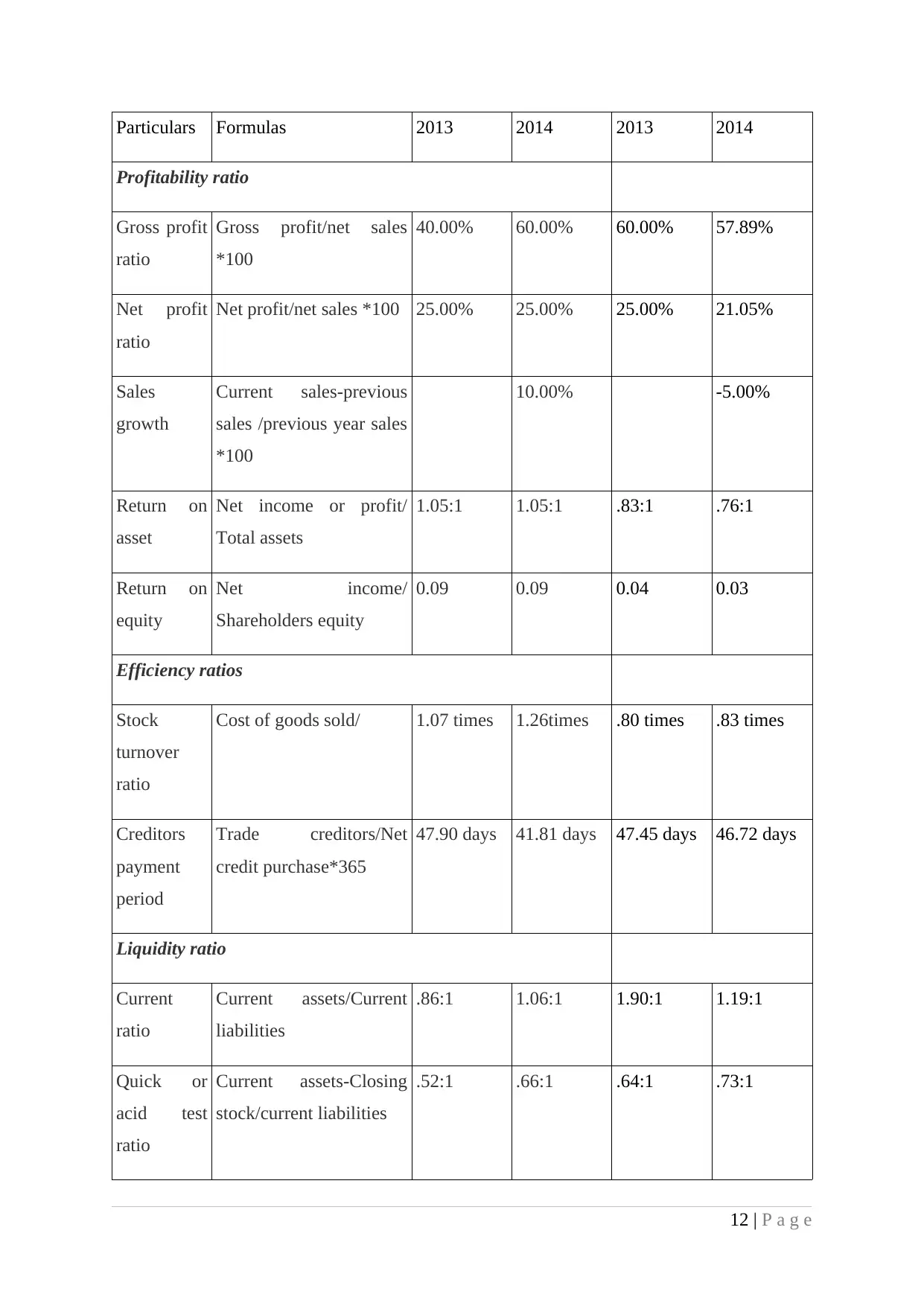
Particulars Formulas 2013 2014 2013 2014
Profitability ratio
Gross profit
ratio
Gross profit/net sales
*100
40.00% 60.00% 60.00% 57.89%
Net profit
ratio
Net profit/net sales *100 25.00% 25.00% 25.00% 21.05%
Sales
growth
Current sales-previous
sales /previous year sales
*100
10.00% -5.00%
Return on
asset
Net income or profit/
Total assets
1.05:1 1.05:1 .83:1 .76:1
Return on
equity
Net income/
Shareholders equity
0.09 0.09 0.04 0.03
Efficiency ratios
Stock
turnover
ratio
Cost of goods sold/ 1.07 times 1.26times .80 times .83 times
Creditors
payment
period
Trade creditors/Net
credit purchase*365
47.90 days 41.81 days 47.45 days 46.72 days
Liquidity ratio
Current
ratio
Current assets/Current
liabilities
.86:1 1.06:1 1.90:1 1.19:1
Quick or
acid test
ratio
Current assets-Closing
stock/current liabilities
.52:1 .66:1 .64:1 .73:1
12 | P a g e
Profitability ratio
Gross profit
ratio
Gross profit/net sales
*100
40.00% 60.00% 60.00% 57.89%
Net profit
ratio
Net profit/net sales *100 25.00% 25.00% 25.00% 21.05%
Sales
growth
Current sales-previous
sales /previous year sales
*100
10.00% -5.00%
Return on
asset
Net income or profit/
Total assets
1.05:1 1.05:1 .83:1 .76:1
Return on
equity
Net income/
Shareholders equity
0.09 0.09 0.04 0.03
Efficiency ratios
Stock
turnover
ratio
Cost of goods sold/ 1.07 times 1.26times .80 times .83 times
Creditors
payment
period
Trade creditors/Net
credit purchase*365
47.90 days 41.81 days 47.45 days 46.72 days
Liquidity ratio
Current
ratio
Current assets/Current
liabilities
.86:1 1.06:1 1.90:1 1.19:1
Quick or
acid test
ratio
Current assets-Closing
stock/current liabilities
.52:1 .66:1 .64:1 .73:1
12 | P a g e
⊘ This is a preview!⊘
Do you want full access?
Subscribe today to unlock all pages.

Trusted by 1+ million students worldwide
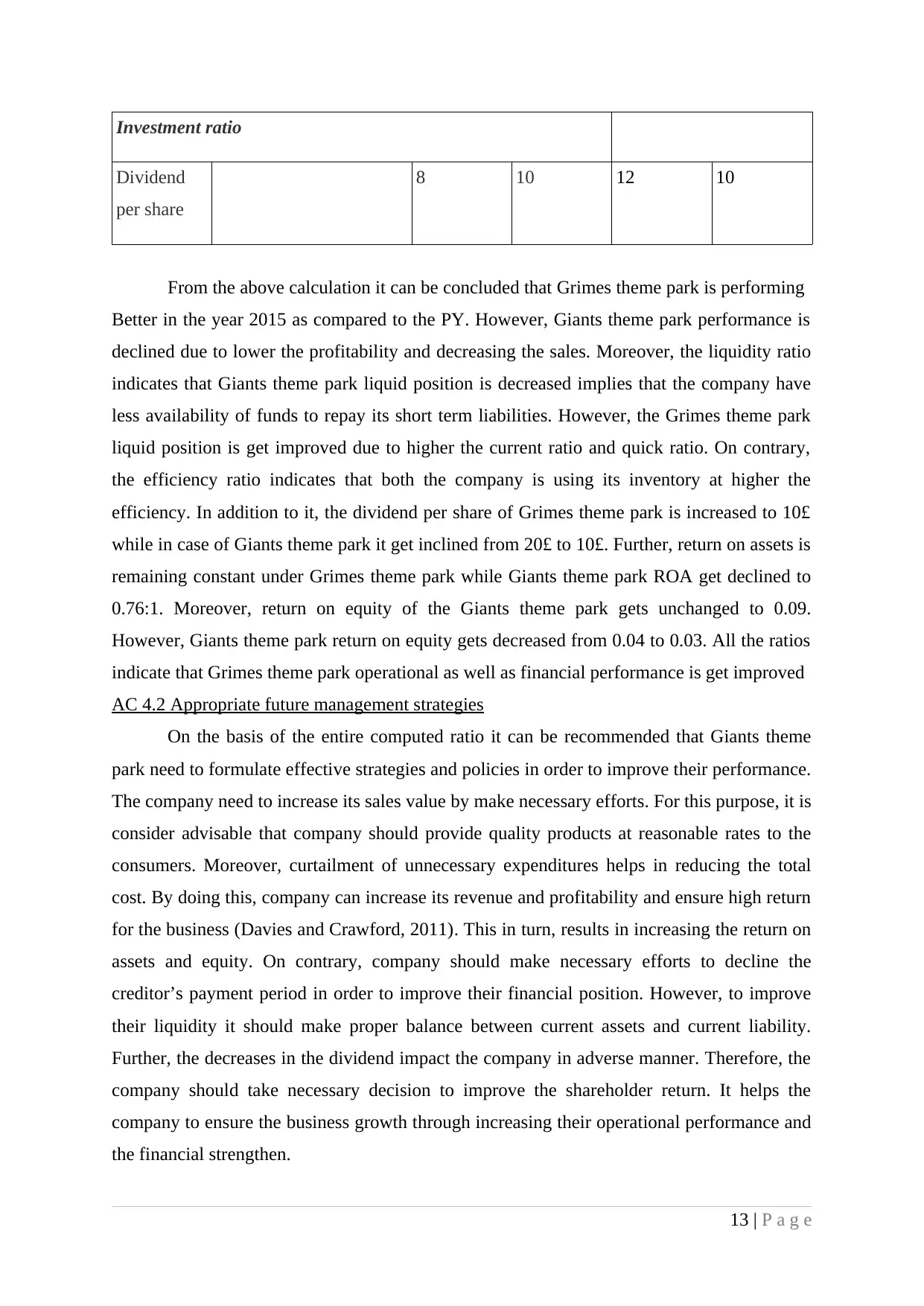
Investment ratio
Dividend
per share
8 10 12 10
From the above calculation it can be concluded that Grimes theme park is performing
Better in the year 2015 as compared to the PY. However, Giants theme park performance is
declined due to lower the profitability and decreasing the sales. Moreover, the liquidity ratio
indicates that Giants theme park liquid position is decreased implies that the company have
less availability of funds to repay its short term liabilities. However, the Grimes theme park
liquid position is get improved due to higher the current ratio and quick ratio. On contrary,
the efficiency ratio indicates that both the company is using its inventory at higher the
efficiency. In addition to it, the dividend per share of Grimes theme park is increased to 10£
while in case of Giants theme park it get inclined from 20£ to 10£. Further, return on assets is
remaining constant under Grimes theme park while Giants theme park ROA get declined to
0.76:1. Moreover, return on equity of the Giants theme park gets unchanged to 0.09.
However, Giants theme park return on equity gets decreased from 0.04 to 0.03. All the ratios
indicate that Grimes theme park operational as well as financial performance is get improved
AC 4.2 Appropriate future management strategies
On the basis of the entire computed ratio it can be recommended that Giants theme
park need to formulate effective strategies and policies in order to improve their performance.
The company need to increase its sales value by make necessary efforts. For this purpose, it is
consider advisable that company should provide quality products at reasonable rates to the
consumers. Moreover, curtailment of unnecessary expenditures helps in reducing the total
cost. By doing this, company can increase its revenue and profitability and ensure high return
for the business (Davies and Crawford, 2011). This in turn, results in increasing the return on
assets and equity. On contrary, company should make necessary efforts to decline the
creditor’s payment period in order to improve their financial position. However, to improve
their liquidity it should make proper balance between current assets and current liability.
Further, the decreases in the dividend impact the company in adverse manner. Therefore, the
company should take necessary decision to improve the shareholder return. It helps the
company to ensure the business growth through increasing their operational performance and
the financial strengthen.
13 | P a g e
Dividend
per share
8 10 12 10
From the above calculation it can be concluded that Grimes theme park is performing
Better in the year 2015 as compared to the PY. However, Giants theme park performance is
declined due to lower the profitability and decreasing the sales. Moreover, the liquidity ratio
indicates that Giants theme park liquid position is decreased implies that the company have
less availability of funds to repay its short term liabilities. However, the Grimes theme park
liquid position is get improved due to higher the current ratio and quick ratio. On contrary,
the efficiency ratio indicates that both the company is using its inventory at higher the
efficiency. In addition to it, the dividend per share of Grimes theme park is increased to 10£
while in case of Giants theme park it get inclined from 20£ to 10£. Further, return on assets is
remaining constant under Grimes theme park while Giants theme park ROA get declined to
0.76:1. Moreover, return on equity of the Giants theme park gets unchanged to 0.09.
However, Giants theme park return on equity gets decreased from 0.04 to 0.03. All the ratios
indicate that Grimes theme park operational as well as financial performance is get improved
AC 4.2 Appropriate future management strategies
On the basis of the entire computed ratio it can be recommended that Giants theme
park need to formulate effective strategies and policies in order to improve their performance.
The company need to increase its sales value by make necessary efforts. For this purpose, it is
consider advisable that company should provide quality products at reasonable rates to the
consumers. Moreover, curtailment of unnecessary expenditures helps in reducing the total
cost. By doing this, company can increase its revenue and profitability and ensure high return
for the business (Davies and Crawford, 2011). This in turn, results in increasing the return on
assets and equity. On contrary, company should make necessary efforts to decline the
creditor’s payment period in order to improve their financial position. However, to improve
their liquidity it should make proper balance between current assets and current liability.
Further, the decreases in the dividend impact the company in adverse manner. Therefore, the
company should take necessary decision to improve the shareholder return. It helps the
company to ensure the business growth through increasing their operational performance and
the financial strengthen.
13 | P a g e
Paraphrase This Document
Need a fresh take? Get an instant paraphrase of this document with our AI Paraphraser
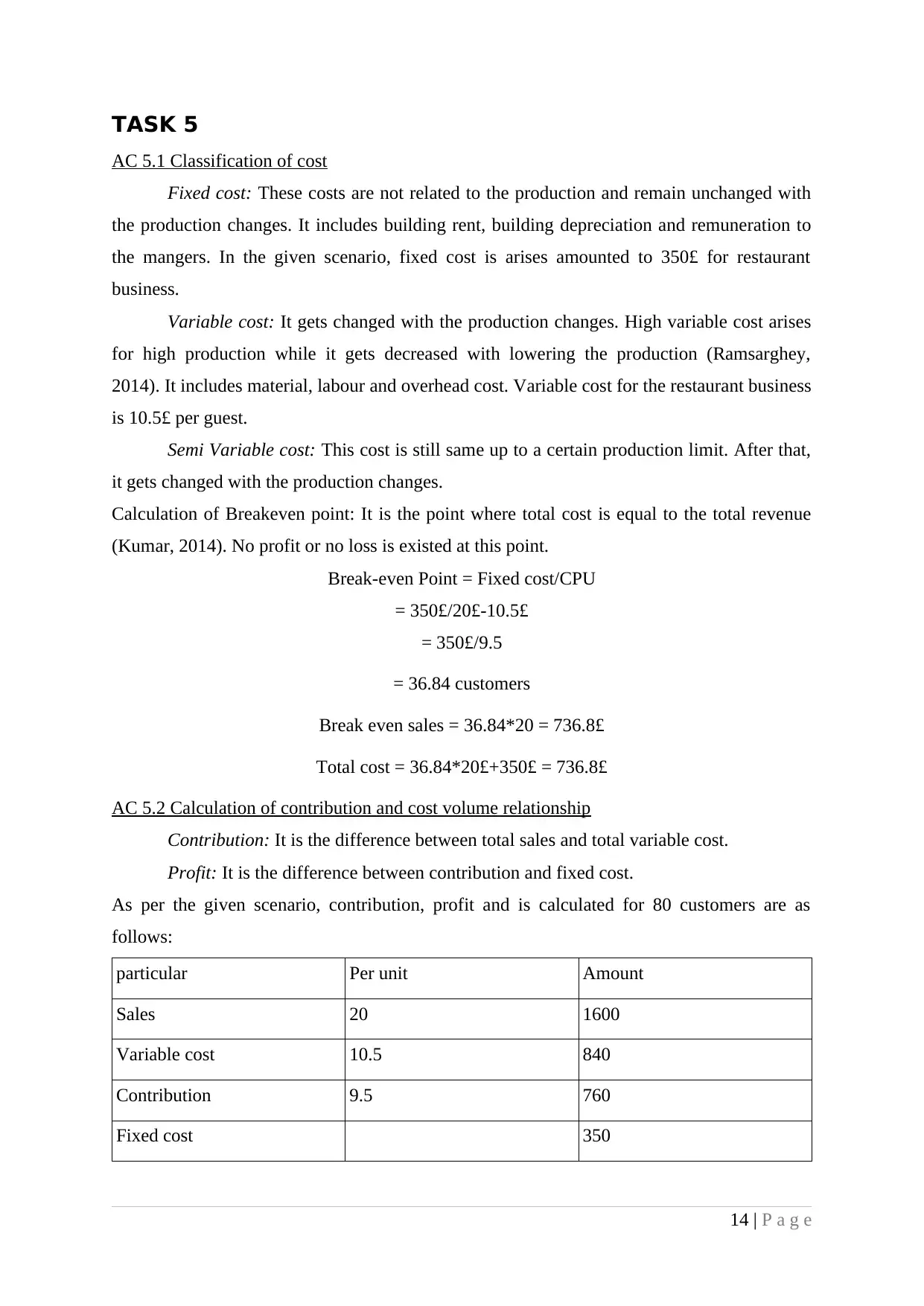
TASK 5
AC 5.1 Classification of cost
Fixed cost: These costs are not related to the production and remain unchanged with
the production changes. It includes building rent, building depreciation and remuneration to
the mangers. In the given scenario, fixed cost is arises amounted to 350£ for restaurant
business.
Variable cost: It gets changed with the production changes. High variable cost arises
for high production while it gets decreased with lowering the production (Ramsarghey,
2014). It includes material, labour and overhead cost. Variable cost for the restaurant business
is 10.5£ per guest.
Semi Variable cost: This cost is still same up to a certain production limit. After that,
it gets changed with the production changes.
Calculation of Breakeven point: It is the point where total cost is equal to the total revenue
(Kumar, 2014). No profit or no loss is existed at this point.
Break-even Point = Fixed cost/CPU
= 350£/20£-10.5£
= 350£/9.5
= 36.84 customers
Break even sales = 36.84*20 = 736.8£
Total cost = 36.84*20£+350£ = 736.8£
AC 5.2 Calculation of contribution and cost volume relationship
Contribution: It is the difference between total sales and total variable cost.
Profit: It is the difference between contribution and fixed cost.
As per the given scenario, contribution, profit and is calculated for 80 customers are as
follows:
particular Per unit Amount
Sales 20 1600
Variable cost 10.5 840
Contribution 9.5 760
Fixed cost 350
14 | P a g e
AC 5.1 Classification of cost
Fixed cost: These costs are not related to the production and remain unchanged with
the production changes. It includes building rent, building depreciation and remuneration to
the mangers. In the given scenario, fixed cost is arises amounted to 350£ for restaurant
business.
Variable cost: It gets changed with the production changes. High variable cost arises
for high production while it gets decreased with lowering the production (Ramsarghey,
2014). It includes material, labour and overhead cost. Variable cost for the restaurant business
is 10.5£ per guest.
Semi Variable cost: This cost is still same up to a certain production limit. After that,
it gets changed with the production changes.
Calculation of Breakeven point: It is the point where total cost is equal to the total revenue
(Kumar, 2014). No profit or no loss is existed at this point.
Break-even Point = Fixed cost/CPU
= 350£/20£-10.5£
= 350£/9.5
= 36.84 customers
Break even sales = 36.84*20 = 736.8£
Total cost = 36.84*20£+350£ = 736.8£
AC 5.2 Calculation of contribution and cost volume relationship
Contribution: It is the difference between total sales and total variable cost.
Profit: It is the difference between contribution and fixed cost.
As per the given scenario, contribution, profit and is calculated for 80 customers are as
follows:
particular Per unit Amount
Sales 20 1600
Variable cost 10.5 840
Contribution 9.5 760
Fixed cost 350
14 | P a g e
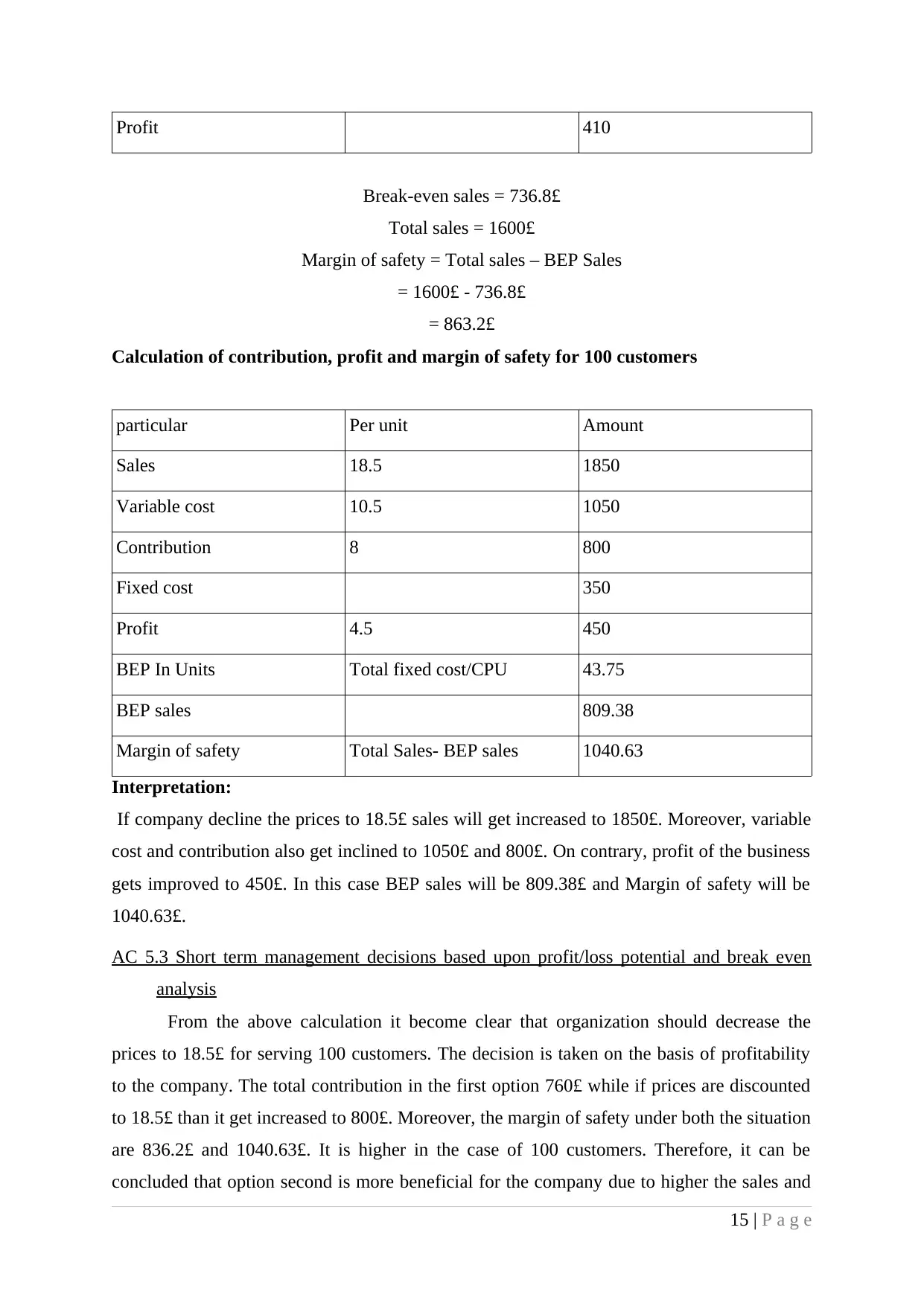
Profit 410
Break-even sales = 736.8£
Total sales = 1600£
Margin of safety = Total sales – BEP Sales
= 1600£ - 736.8£
= 863.2£
Calculation of contribution, profit and margin of safety for 100 customers
particular Per unit Amount
Sales 18.5 1850
Variable cost 10.5 1050
Contribution 8 800
Fixed cost 350
Profit 4.5 450
BEP In Units Total fixed cost/CPU 43.75
BEP sales 809.38
Margin of safety Total Sales- BEP sales 1040.63
Interpretation:
If company decline the prices to 18.5£ sales will get increased to 1850£. Moreover, variable
cost and contribution also get inclined to 1050£ and 800£. On contrary, profit of the business
gets improved to 450£. In this case BEP sales will be 809.38£ and Margin of safety will be
1040.63£.
AC 5.3 Short term management decisions based upon profit/loss potential and break even
analysis
From the above calculation it become clear that organization should decrease the
prices to 18.5£ for serving 100 customers. The decision is taken on the basis of profitability
to the company. The total contribution in the first option 760£ while if prices are discounted
to 18.5£ than it get increased to 800£. Moreover, the margin of safety under both the situation
are 836.2£ and 1040.63£. It is higher in the case of 100 customers. Therefore, it can be
concluded that option second is more beneficial for the company due to higher the sales and
15 | P a g e
Break-even sales = 736.8£
Total sales = 1600£
Margin of safety = Total sales – BEP Sales
= 1600£ - 736.8£
= 863.2£
Calculation of contribution, profit and margin of safety for 100 customers
particular Per unit Amount
Sales 18.5 1850
Variable cost 10.5 1050
Contribution 8 800
Fixed cost 350
Profit 4.5 450
BEP In Units Total fixed cost/CPU 43.75
BEP sales 809.38
Margin of safety Total Sales- BEP sales 1040.63
Interpretation:
If company decline the prices to 18.5£ sales will get increased to 1850£. Moreover, variable
cost and contribution also get inclined to 1050£ and 800£. On contrary, profit of the business
gets improved to 450£. In this case BEP sales will be 809.38£ and Margin of safety will be
1040.63£.
AC 5.3 Short term management decisions based upon profit/loss potential and break even
analysis
From the above calculation it become clear that organization should decrease the
prices to 18.5£ for serving 100 customers. The decision is taken on the basis of profitability
to the company. The total contribution in the first option 760£ while if prices are discounted
to 18.5£ than it get increased to 800£. Moreover, the margin of safety under both the situation
are 836.2£ and 1040.63£. It is higher in the case of 100 customers. Therefore, it can be
concluded that option second is more beneficial for the company due to higher the sales and
15 | P a g e
⊘ This is a preview!⊘
Do you want full access?
Subscribe today to unlock all pages.

Trusted by 1+ million students worldwide
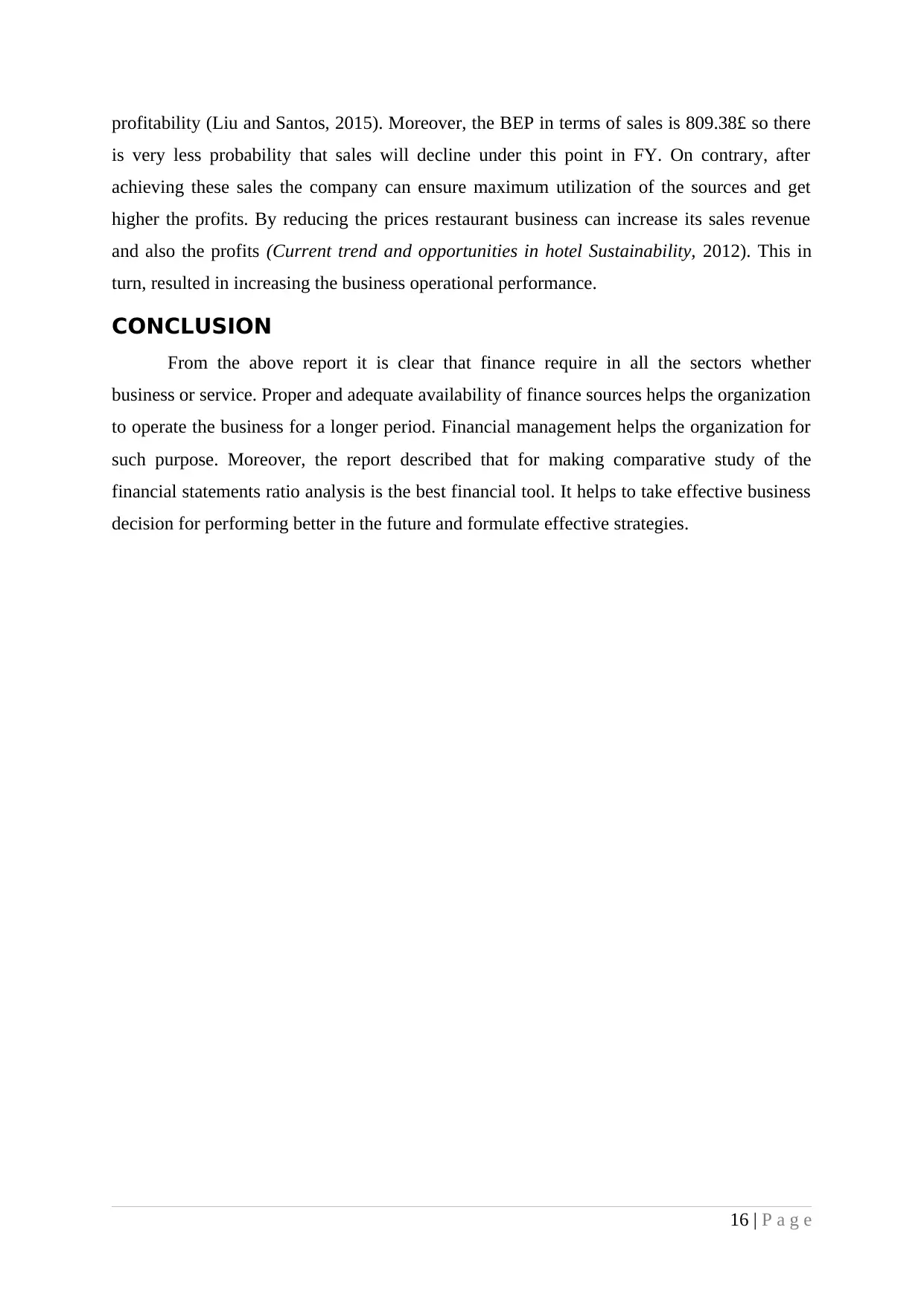
profitability (Liu and Santos, 2015). Moreover, the BEP in terms of sales is 809.38£ so there
is very less probability that sales will decline under this point in FY. On contrary, after
achieving these sales the company can ensure maximum utilization of the sources and get
higher the profits. By reducing the prices restaurant business can increase its sales revenue
and also the profits (Current trend and opportunities in hotel Sustainability, 2012). This in
turn, resulted in increasing the business operational performance.
CONCLUSION
From the above report it is clear that finance require in all the sectors whether
business or service. Proper and adequate availability of finance sources helps the organization
to operate the business for a longer period. Financial management helps the organization for
such purpose. Moreover, the report described that for making comparative study of the
financial statements ratio analysis is the best financial tool. It helps to take effective business
decision for performing better in the future and formulate effective strategies.
16 | P a g e
is very less probability that sales will decline under this point in FY. On contrary, after
achieving these sales the company can ensure maximum utilization of the sources and get
higher the profits. By reducing the prices restaurant business can increase its sales revenue
and also the profits (Current trend and opportunities in hotel Sustainability, 2012). This in
turn, resulted in increasing the business operational performance.
CONCLUSION
From the above report it is clear that finance require in all the sectors whether
business or service. Proper and adequate availability of finance sources helps the organization
to operate the business for a longer period. Financial management helps the organization for
such purpose. Moreover, the report described that for making comparative study of the
financial statements ratio analysis is the best financial tool. It helps to take effective business
decision for performing better in the future and formulate effective strategies.
16 | P a g e
Paraphrase This Document
Need a fresh take? Get an instant paraphrase of this document with our AI Paraphraser
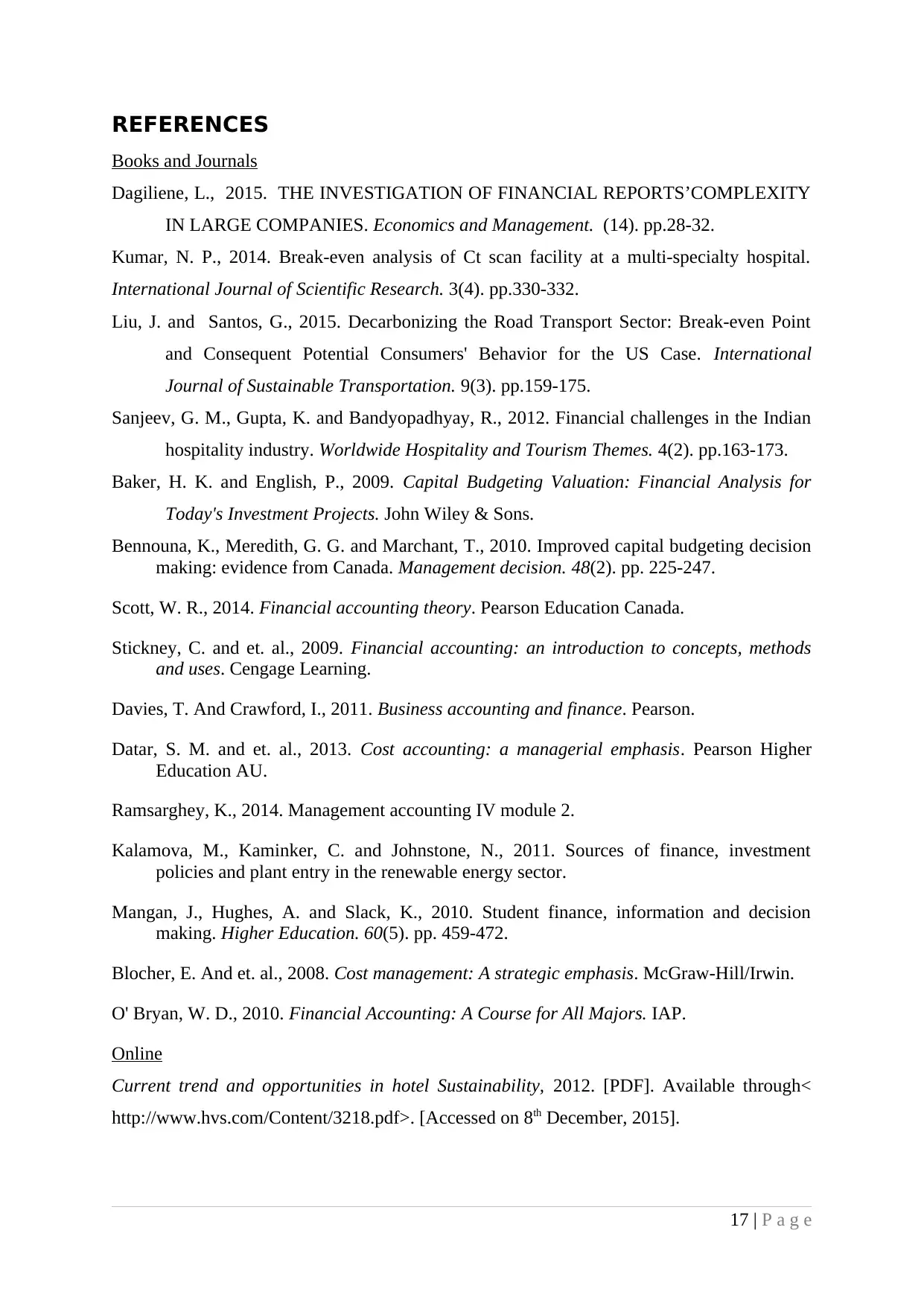
REFERENCES
Books and Journals
Dagiliene, L., 2015. THE INVESTIGATION OF FINANCIAL REPORTS’COMPLEXITY
IN LARGE COMPANIES. Economics and Management. (14). pp.28-32.
Kumar, N. P., 2014. Break-even analysis of Ct scan facility at a multi-specialty hospital.
International Journal of Scientific Research. 3(4). pp.330-332.
Liu, J. and Santos, G., 2015. Decarbonizing the Road Transport Sector: Break-even Point
and Consequent Potential Consumers' Behavior for the US Case. International
Journal of Sustainable Transportation. 9(3). pp.159-175.
Sanjeev, G. M., Gupta, K. and Bandyopadhyay, R., 2012. Financial challenges in the Indian
hospitality industry. Worldwide Hospitality and Tourism Themes. 4(2). pp.163-173.
Baker, H. K. and English, P., 2009. Capital Budgeting Valuation: Financial Analysis for
Today's Investment Projects. John Wiley & Sons.
Bennouna, K., Meredith, G. G. and Marchant, T., 2010. Improved capital budgeting decision
making: evidence from Canada. Management decision. 48(2). pp. 225-247.
Scott, W. R., 2014. Financial accounting theory. Pearson Education Canada.
Stickney, C. and et. al., 2009. Financial accounting: an introduction to concepts, methods
and uses. Cengage Learning.
Davies, T. And Crawford, I., 2011. Business accounting and finance. Pearson.
Datar, S. M. and et. al., 2013. Cost accounting: a managerial emphasis. Pearson Higher
Education AU.
Ramsarghey, K., 2014. Management accounting IV module 2.
Kalamova, M., Kaminker, C. and Johnstone, N., 2011. Sources of finance, investment
policies and plant entry in the renewable energy sector.
Mangan, J., Hughes, A. and Slack, K., 2010. Student finance, information and decision
making. Higher Education. 60(5). pp. 459-472.
Blocher, E. And et. al., 2008. Cost management: A strategic emphasis. McGraw-Hill/Irwin.
O' Bryan, W. D., 2010. Financial Accounting: A Course for All Majors. IAP.
Online
Current trend and opportunities in hotel Sustainability, 2012. [PDF]. Available through<
http://www.hvs.com/Content/3218.pdf>. [Accessed on 8th December, 2015].
17 | P a g e
Books and Journals
Dagiliene, L., 2015. THE INVESTIGATION OF FINANCIAL REPORTS’COMPLEXITY
IN LARGE COMPANIES. Economics and Management. (14). pp.28-32.
Kumar, N. P., 2014. Break-even analysis of Ct scan facility at a multi-specialty hospital.
International Journal of Scientific Research. 3(4). pp.330-332.
Liu, J. and Santos, G., 2015. Decarbonizing the Road Transport Sector: Break-even Point
and Consequent Potential Consumers' Behavior for the US Case. International
Journal of Sustainable Transportation. 9(3). pp.159-175.
Sanjeev, G. M., Gupta, K. and Bandyopadhyay, R., 2012. Financial challenges in the Indian
hospitality industry. Worldwide Hospitality and Tourism Themes. 4(2). pp.163-173.
Baker, H. K. and English, P., 2009. Capital Budgeting Valuation: Financial Analysis for
Today's Investment Projects. John Wiley & Sons.
Bennouna, K., Meredith, G. G. and Marchant, T., 2010. Improved capital budgeting decision
making: evidence from Canada. Management decision. 48(2). pp. 225-247.
Scott, W. R., 2014. Financial accounting theory. Pearson Education Canada.
Stickney, C. and et. al., 2009. Financial accounting: an introduction to concepts, methods
and uses. Cengage Learning.
Davies, T. And Crawford, I., 2011. Business accounting and finance. Pearson.
Datar, S. M. and et. al., 2013. Cost accounting: a managerial emphasis. Pearson Higher
Education AU.
Ramsarghey, K., 2014. Management accounting IV module 2.
Kalamova, M., Kaminker, C. and Johnstone, N., 2011. Sources of finance, investment
policies and plant entry in the renewable energy sector.
Mangan, J., Hughes, A. and Slack, K., 2010. Student finance, information and decision
making. Higher Education. 60(5). pp. 459-472.
Blocher, E. And et. al., 2008. Cost management: A strategic emphasis. McGraw-Hill/Irwin.
O' Bryan, W. D., 2010. Financial Accounting: A Course for All Majors. IAP.
Online
Current trend and opportunities in hotel Sustainability, 2012. [PDF]. Available through<
http://www.hvs.com/Content/3218.pdf>. [Accessed on 8th December, 2015].
17 | P a g e
1 out of 17
Related Documents
Your All-in-One AI-Powered Toolkit for Academic Success.
+13062052269
info@desklib.com
Available 24*7 on WhatsApp / Email
![[object Object]](/_next/static/media/star-bottom.7253800d.svg)
Unlock your academic potential
© 2024 | Zucol Services PVT LTD | All rights reserved.





